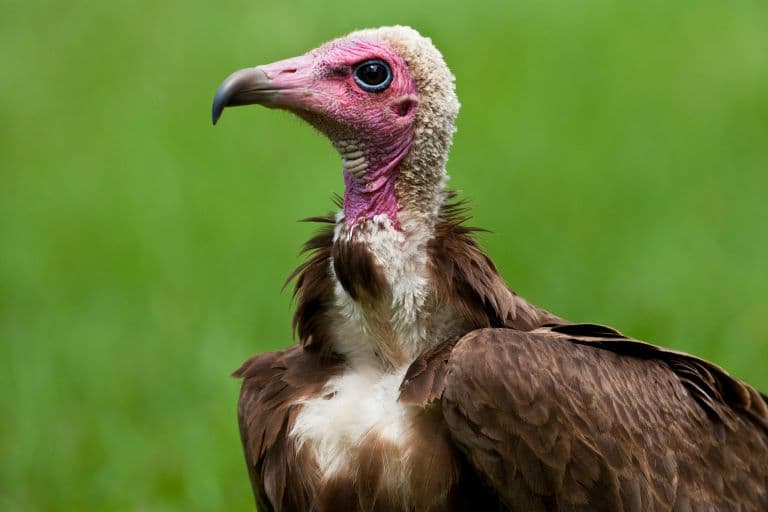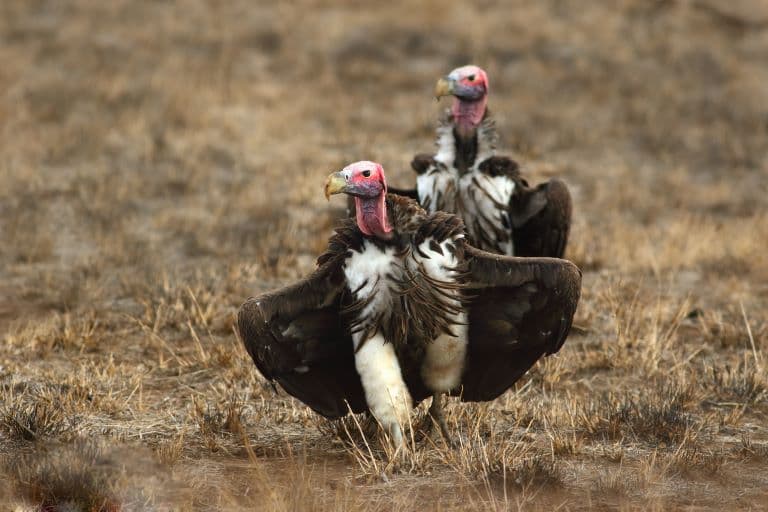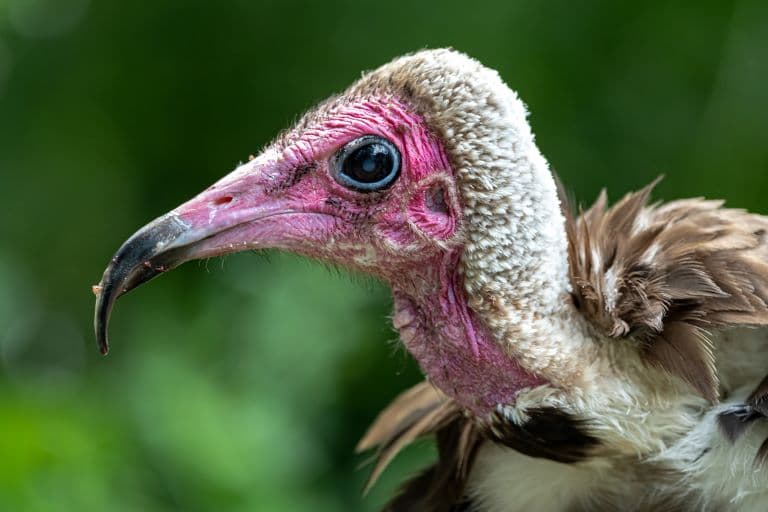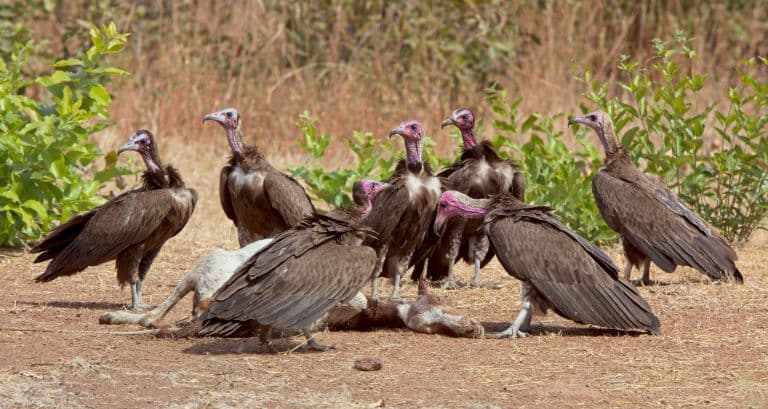Hooded Vulture Profile
Vultures are in great trouble all over the world, with more threats against their existence than any group of birds this diverse. Not only do they have a bad reputation as killers of livestock (something which they are unfairly blamed for!), but they also upset poachers by giving their game away.
The hooded vulture is showing great signs of adaptability, able to withstand and even thrive in the relentless expansion of human urban and agricultural development. While it still faces all of the threats against vultures, this might be what saves it.

Hooded Vulture Facts Overview
| Habitat: | Open grassland, forest edge, wooded savanna, deserts and urban |
| Location: | Subsaharan Africa |
| Lifespan: | Unknown |
| Size: | 72 cm (28 in) long, 180 cm (71 in) wingspan |
| Weight: | 2.6 kg (5.7 lb) |
| Colour: | Dark brown, with a pink head |
| Diet: | Generalist carrion feeders |
| Predators: | Few to none |
| Top Speed: | Unknown |
| No. of Species: | 1 |
| Conservation Status: | Critically endangered (IUCN) |
Hooded vultures are valuable human companions, able to withstand development better than most species, and providing a useful clean-up service for the ever-growing human populations.
They’re still in serious trouble and are listed as critically endangered, but their ability to cohabit with humans might provide them with an advantage over other species.
Interesting Hooded Vulture Facts
1. They’re well-adapted to running
Unlike perching birds, these vultures have feet that are better equipped for moving along the ground. Their toes are strong, but they’re not designed for grabbing, either, like some of the other large raptors. Instead, they’re flattened and stiffened, which allows the hooded vulture to run better.
Other adaptations to this lifestyle include a very thin beak with a pronounced downward hook at the end. This is ideal for tearing into dead meat and shows that the bird has evolved as a carrion-feeder, rather than a hunter.

2. Females have longer eyelashes
One of the cutest ways to tell the sexes apart is to get them to flutter their eyelids at you. Female hooded vultures look remarkably similar to males and juveniles and adults also look quite alike, both in size and colouration, but females have much longer eyelashes.
These eyelashes are actually modified feathers, and it’s not clear why there’s a difference between males and females, but it might be the only way they can tell the sex of their partners too! 1
3. Pink faces are hot
Their pink faces might also have something to do with the sexes, and their purpose is still a matter of contention.
We know that bald-headed vultures benefit from less detritus and rotting flesh stuck to their feathers, but in the hooded vulture, they appear to be exceptionally pink.
This might be a way of showing virility; an opportunity to demonstrate bright colourations that are nutritionally expensive to show potential mates that an individual is fit to bear children.
Regardless, one way or another, when these usually quiet birds get it on, they are happy to break their silence.

4. Sex whistles
Hooded vultures are usually not very vocal at all. They will go about most of their lives never uttering a word, but when it’s mating time, a celebratory shrill whistle can be heard, and squealing commences.
This excited ejaculation is also sometimes heard when a carcass is found, suggesting it’s an expression of success.
If the success is effective, nests will soon be built in palm trees, and a single egg laid inside it. 2
5. They’re not afraid of people
If palm trees can’t be found, this species is quite content to nest in tall buildings. In fact, their adaptability to new habitats has led them to become quite at peace around human civilization.
This species is commonly found in urban environments and around agriculture, and anywhere they can nest above about 15 meters up. There’s often enough carrion around people that the species actually thrive in these environments. 3
6. They’re an important clean-up crew
While people provide much of the bird’s needs, they’re also beneficiaries of the services these vultures can provide.
Removing corpses can be a tricky process, and leaving them there brings various unpleasant consequences, so the vultures act as a hygienic solution to the problem of dead animals. Vultures are much better than feral dogs in this regard, as they don’t spread rabies and leave less of a mess. 4

7. They like to crap on students
One study measured vulture concentrations by the number of people the birds have shat on.
Almost half of the university students surveyed in Ghana admitted to being on the receiving end of some gravitating guano at least once a month. And the birds seem to time their arrival in conjunction with the school calendar, following students and their organic waste around the city. 5
8. They’re in decline
Despite the intricate relationship of nutrient exchange between humans and hooded vultures, the birds are still in decline. A lot of this appears to be related to the ongoing vulture crisis, but there are still many stable populations.
It’s hard to envision the future of the species as a whole, but it’s undoubtedly that there are many threats, and the species is in dire need of support. 6
9. They get poisoned by accident
The most significant threat is one that we see time and time again in vultures. Indirect poisoning either via ingestion of lead shot from carcasses or intoxication of diclofenac from eating dead livestock.
But this species is also hunted for traditional medicine and witchcraft and is sometimes killed as a pest. In one assessment, 90% of all bird parts traded in Nigeria were found to be hooded vultures.
In some places, their meat is sold as chicken, and some suggest that poachers of larger, protected animals like elephants kill vultures to prevent them from giving away the position of the poachers. 7
10. They’re the most stable vultures in Africa
Despite being critically endangered, they seem to have reached a shaly equilibrium in some locations. Their ability to coincide with humans might represent a lower threshold for their existence, and provide a safety net where other species would perish.
As of now, they’re more stable than other species of vulture and may have more chance of being saved. 8
Hooded Vulture Fact-File Summary
Scientific Classification
| Kingdom: | Animalia |
| Phylum: | Chordata |
| Class: | Aves |
| Order: | Accipitriformes |
| Family: | Accipitridae |
| Genus: | Necrosyrtes |
| Species: | Monachus |
Fact Sources & References
- Great Big Story (2016), “Hard Times for Roughnecks: The Critically Endangered Hooded Vulture”, YouTube.
- “Hooded Vulture: The Ultimate Guide”, Operation Migration.
- Clément Daboné (2018), “Impact of human activities on the reproduction of Hooded Vultures Necrosyrtes monachus in Burkina Faso”, Taylor & Francis Online.
- “Necrosyrtes monachus hooded vulture”, Animal Diversity Web
- (2008), “Waste management and Hooded Vultures on the Legon Campus of the University of Ghana in Accra, Ghana, West Africa”, African Journals Online.
- “Hooded Vulture”, IUCN Red List.
- “Hooded Vulture Necrosyrtes monachus”, Bird Life International.
- “Necrosyrtes monachus hooded vulture”, Animal Diversity Web.
